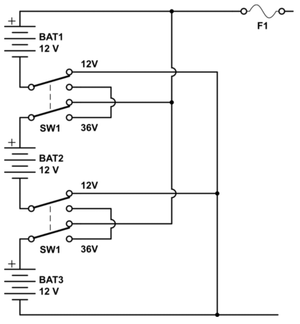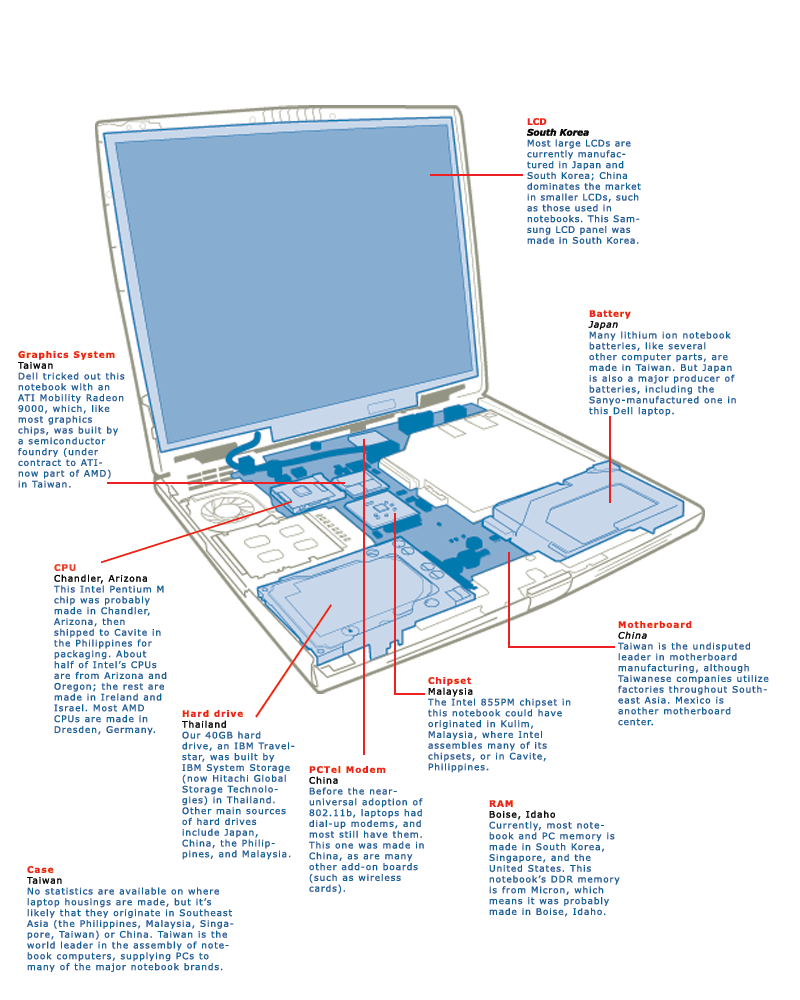
Here at PC Magazine, we’ve been prying open notebooks ever since notebooks existed. We can’t help it–we’re just curious. But this kind of curiosity is hard on the computers themselves. (To the many manufacturers whose fine products we’ve destroyed over the years: We’re sorry. Really.) If you’re curious too, put down your screwdriver and take a look at the following pages. By focusing our attention on one small part of your computer, we aim to show you what’s inside a typical notebook, where all those parts come from, and what materials they’re made of. And we look at the hazards some of those components may present. The big picture is one of a strikingly global production chain.
This is the story of how quartz becomes a computer, and it’s a story that–for the typical notebook computer–stretches across nearly every continent, dozens of countries, and literally hundreds of different companies.
At its center is the heart of every computer, the microprocessor–a tiny flake of silicon whose millions of microscopic, precision-engineered circuits do computational work that would have been unthinkable just 30 years ago. But before it becomes a microchip, that little bit of silicon starts out the same way a gravel road does: as a pile of rock chips, hammered out of an open-pit quarry by dynamite and heavy machinery.
Just who ultimately transforms that silicon into a PC might surprise you. “HP or Dell computers basically don’t have anything HP or Dell inside them,” says Eric Williams, an assistant professor of civil engineering at Arizona State University who has done extensive research into the PC supply chain. “[Those companies are] designers of computers, purchasers of components, and assemblers. They may even contract out the assembly.”
It would be impossible to trace in a magazine article the origin of every single component in your notebook, because it contains hundreds of parts, including microchips, the hard drive, the battery pack, the LCD, circuit boards, resistors, capacitors, wires, and even the pieces of metal and plastic that make up the casing. But we can take a look at the web of production leading up to one component–the CPU–and use that to shed some light on just how global the PC industry has become.
Birth of a Microchip
All microprocessors begin life as a pile of quartz chips, plus a source of carbon–usually charcoal or coal. Quartz, whose main ingredient is silica, is one of the most abundant minerals on the Earth’s surface, and it’s mined all over the world. Charcoal is similarly widespread; all you need is wood and an oven to make it.
This fundamental simplicity means silicon could be produced almost anywhere. In practice, however, the major producers of silicon are industrialized countries where there’s a market for the metal, led by China, the United States, Brazil, and Norway. So let’s say our CPU starts life as a pile of quartz and carbon in a factory in Brazil. After being heated in an electrical furnace to 2,000 degrees C, the silica and carbon react to form molten silicon and carbon dioxide.
Impurities are skimmed off the top of the silicon, and it’s further purified by bubbling oxygen and other gases through the liquid. Afterward, the silicon metal is poured into ingots for sale.
At this point, industrial-grade silicon is about 95 to 99 percent pure. But it needs to be far purer than that before it is usable in the electronics industry. So silicon metal next travels to a refining company, such as Germany’s Wacker Chemie or U.S.-based Dow Corning. It’s combined with hydro-chloric acid to form trichlorosilane, a volatile liquid that is repeatedly distilled and purified.
Afterward, the trichlorosilane is converted to polysilicon (a form of silicon that’s 99.9999 percent pure) and hydrochloric acid. The United States is the leading producer of polysilicon, followed by Japan.
Assembling the Circuits
Next, the block of polysilicon journeys to a wafer fabrication facility. Silicon wafers are the foundation on which all microchips are built. Each is a thin, circular plate of extremely pure silicon, typically 150mm, 200mm, or 300mm in diameter and between 0.5mm and 0.75mm thick. Japan is the largest producer of silicon wafers, with the U.S. coming in second.
At the wafer factory, polysilicon is melted in a fused silica crucible and then carefully crystallized into cylindrical silicon ingots. The ingots are sawn into thin circular wafers, which are polished until they’re extremely flat. Finally, silicon wafers are shipped to the chip foundry, where they will be made into microprocessors.
In the entire PC production chain, this is the one step in which the United States still has a stake in production. Intel makes about half of its CPUs in the U.S., although it is expanding production to overseas factories in Leixlip, Ireland, and in Jerusalem. AMD makes the majority of its chips in Dresden, Germany.
Once complete, the wafer contains hundreds of tiny, rectangular chips. The chips are tested for flaws while still on the wafer. Then, in Intel’s case, whole wafers are shipped overseas to processing plants in Malaysia or the Philippines, where they’re sawn apart before being tested again and assembled into the familiar ceramic packages with wires sticking out of them–what most of us would recognize as “chips.”
From CPU to PC
The next step in the assembly of a notebook is placing the chip on a printed circuit board–the notebook’s motherboard. This final leg of the journey begins, most likely, in a factory just outside of Shanghai, China.
Circuit boards are typically made of epoxy and glass or ceramic, upon which circuits made of copper paths have been etched using a process similar to the one used in microchip fabrication, except on a far larger scale. Taiwan entered the motherboard manufacturing market in the late 1970s and quickly dominated the industry. But Taiwanese manufacturers now outsource most of the manufacturing of their boards to China, where labor is cheaper.
In addition to the CPU, a motherboard uses hundreds of other components, including transistors, resistors, diodes, LEDs, capacitors, and more, all of which are plugged or soldered into place. These are mostly made in China, from a wide variety of materials. For example, transistors and diodes are usually made of silicon or germanium, whereas light-emitting diodes use different compounds, depending on their color (aluminum gallium arsenide for red light, indium gallium nitride for blue).
Additional components, such as modems and wireless cards, may be plugged into the motherboard. A hard drive, optical drive, battery pack, LCD, keyboard, and track pad are all added. The notebook’s external casing is snapped and screwed into place. For almost all of these components, the primary suppliers are in China or Southeast Asia (see the graphic on page 89 for more detailed info).
The final step is adding the branding: the logo identifying a notebook’s ostensible “manufacturer.” The finished notebook is then shipped to a distribution point in the U.S., Europe, or Asia, depending on where it will be sold.
Toxic Electronics?
The list of substances that go into a notebook is long, and many of the chemicals used, such as beryllium, lead, chromium, and mercury compounds, are toxic or carcinogenic to humans. But how much of a risk are these chemicals in reality?
The answer depends on what you mean by risk. For PC users most of these chemicals are not hazardous, since they’re present in very small amounts and are well contained within the notebook’s plastic and metal housing.
The standout exceptions are brominated flame retardants (BFRs), which are used in plastics. Computers and consumer electronics products appear to emit BFRs for some time, and in one recent study, BFRs were found in dust samples taken from dozens of different office environments. The toxicity of BFRs hasn’t been established, but some people are urging manufacturers to play it safe and eliminate them. “We want companies to go completely bromine-free and use compounds that do not off-gas,” says Ted Smith, the founder of the Silicon Valley Toxics Coalition, an environmental advocacy organization.
Apart from user risk, the use of toxic chemicals in notebooks is a concern because of the risks that these chemicals pose to factory workers–and the environmental damage the chemicals may cause if the computer winds up in a landfill.
As a result, the SVTC urges users not to throw out their PCs, and its Computer Take Back Campaign has been pressuring manufacturers to recycle old computers at the end of their useful lives. (Some, including Dell, already do.) For more information and to find a local recycler, visit the group’s site, www.computertakeback.com.
The Well-Traveled Notebook
The end result of this long production chain is that a supposedly American product from a company such as HP, Dell, or Apple is actually built overseas, almost entirely from overseas components.
In fact, “original design manufacturers,” or ODMs, for example Taiwan’s Quanta Computer, Compal Electronics, and AsusTek, handle an increasing amount of the design work, too, leaving their U.S. partners to do little more than advertising, shipping, and billing. According to market analysis firm iSuppli, 82.6 percent of the notebook PCs made in 2006 were assembled by Taiwanese companies, and more than 85 percent of those were built in the greater Shanghai area.
“What’s happened is the Taiwanese ODMs started off in printed circuit-board assembly and motherboard manufacturing in the late 1970s and early 1980s, and they’ve just been climbing that value chain ever since,” says Michael J. Palma, an analyst for IDC. “Laptops are now so embedded in the Asian manufacturing base that they’ll continue to be made there for a long while.”
Whether that represents a triumph or a failure of American industrial ingenuity depends on your perspective. But one thing is sure: Even if you never take your new notebook on a plane, it’s already a well-seasoned world traveler.
Inside A Microprocessor
A modern CPU is a three-dimensional complex of circuits, all resting on a thin subtrate of silicon. One chip may contain up to 20 separate layers.
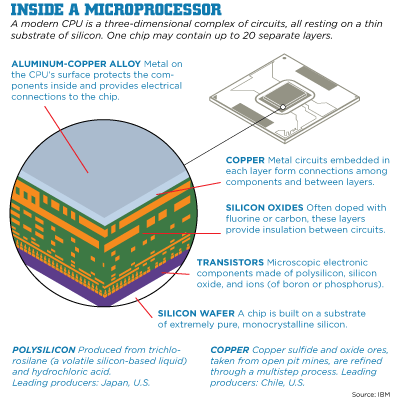
Illustration: Inside a Microprocessor
What–And Where–A Laptop Comes From
This Dell Latitude D600 was reaching the end of its useful life, so we hastened its demise and cracked it open. But please, don’t try this at home. You’ll ruin the notebook–and some components, such as the battery, may be hazardous when opened.

Illustration: Where a Laptop Comes From
Toxics in your PC?
PCs contain a wide range of potentially hazardous chemicals. Although many of these compounds are not dangerous to you as a user (unless you eat your PC), they can still cause environmental problems if your computer isn’t properly recycled.
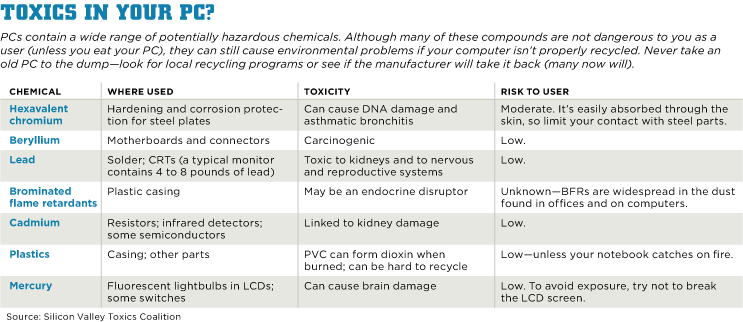
Illustration: Toxics in Your PC?
A Lithium Ion Battery
Most modern notebook batteries use lithium ion or lithium ion polymer technologies. Here’s what a typical lithium ion battery pack looks like–on the inside.
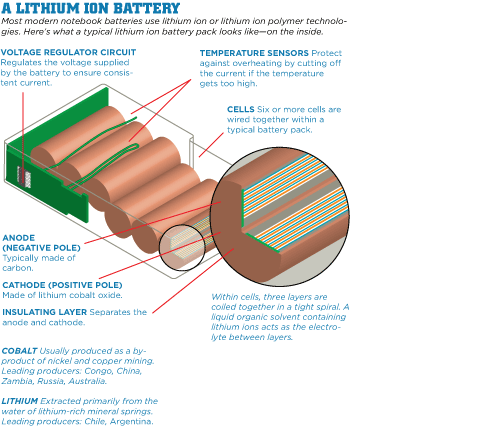
Illustration: Inside a Lithium Ion Battery
Link: What’s Inside Your Laptop?
Link broken? Try the Wayback Machine.
